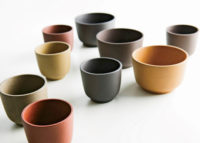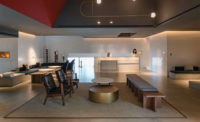Messing with a successful restaurant is a tricky task. While the dining scene demands fresh ideas and style, prestigious establishments often resist change. A facelift to a beloved eatery might backfire, alienating old customers and disappointing new ones. And if the restaurant occupies a space in a landmark building renovated 13 years before by your mentor, an architect’s job becomes that much more difficult. None of this stopped the husband-andwife team of Lyndon Neri and Rossana Hu, partners at Neri&Hu Design and Research Office, from transforming Jean-Georges, the flagship of Jean- Georges Vongerichten’s dining spots in Shanghai. The chef runs three places there, all in the same building— the historic Three on the Bund, a Beaux-Arts pile built in 1916 for the Union Assurance Company and reconfigured by Michael Graves in 2004. Neri and Hu, who worked for Graves in the 1990s and early 2000s, were involved in the Three on the Bund project including the design of the existing Jean-Georges.
Additional Information:
Jump to credits & specifications
“The old restaurant was perfect 13 years ago. But with the shifting culinary climate in Shanghai, Jean- Georges wanted a more modern approach,” says Neri. “The identity needed to stay the same but had to be updated for a city that is becoming more cosmopolitan and global.” So the architects removed the interior partitions, heavy curtains, dark wood paneling, and richly colored seating that gave the old incarnation a clubby, neocolonial feel. Stripping the space back to its 1916 surfaces, Neri and Hu restored the original plaster moldings and cornices in the 9,150-square-foot restaurant and revealed old columns and arches in the reception area. As they have done on other Shanghai projects, such as Waterhouse on South Bund (RECORD, September 2010), Design Republic Commune (RECORD, February 2013), and Mercato by Jean- Georges Vongerichten (RECORD, September 2013), the architects kept some elements—like the chipped column capitals—in their now damaged condition. This strategy leaves a palimpsest of previous eras and highlights the contrast between the old and the new.
While still luxurious, the new Jean- Georges restaurant is a lighter, sleeker animal. Instead of dark, opulent materials, Neri and Hu used white paint, white upholstery, oak floors with a honey stain, cream-colored travertine in the bar, and brass ceilings over the bar and in the restrooms. As they learned to do at Graves’s office, they worked at all scales, designing everything from the chairs and cabinets to the rugs and lights. They opened up the interiors, replacing Graves’s classically proportioned rooms with a large, open dining area and a series of brassframed enclosures for the bar and lounge area, show kitchen, and private dining rooms, as well as for the lavs. To create levels of privacy, they wrapped these spaces with clear and sand-blasted glass and curtains. Throughout the restaurant, they placed antique mirrors etched with texts from French philosophers, adding another layer of history to the mix. The transparent, translucent, and reflective surfaces create a sense of constant interaction and dialogue, says Neri, and generate the energy that Vongerichten wanted.
CreditsArchitect: Architect firm: Neri&Hu Design and Research Office
Personnel in architect's firm who should receive special credit: Lyndon Neri & Rossana Hu (principals in charge)
General contractor: n/A
Photographer: Pedro Pegenaute
|
|
Video © Pedro Pegenaute



















Post a comment to this article
Report Abusive Comment